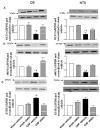Simvastatin treatment attenuates increased respiratory variability and apnea/hypopnea index in rats with chronic heart failure
- PMID: 24516105
- PMCID: PMC3993007
- DOI: 10.1161/HYPERTENSIONAHA.113.02535
Simvastatin treatment attenuates increased respiratory variability and apnea/hypopnea index in rats with chronic heart failure
Abstract
Cheyne-Stokes respiration and cardiac arrhythmias are associated with increased morbidity and mortality in patients with chronic heart failure (CHF). Enhanced carotid body chemoreflex (CBC) sensitivity is associated with these abnormalities in CHF. Reduced carotid body (CB) nitric oxide and nitric oxide synthase (NOS) levels play an important role in the enhanced CBC. In other disease models, Simvastatin (statin) treatment increases endothelial NOS, in part, by increasing Krüppel-like Factor 2 expression. We hypothesized that statin treatment would ameliorate enhanced CBC sensitivity as well as increased respiratory variability, apnea/hypopnea index, and arrhythmia index, in a rodent model of CHF. Resting breathing pattern, cardiac rhythm, and the ventilatory and CB chemoreceptor afferent responses to hypoxia were assessed in rats with CHF induced by coronary ligation. CHF was associated with enhanced ventilatory and CB afferent responses to hypoxia as well as increased respiratory variability, apnea/hypopnea index, and arrhythmia index. Statin treatment prevented the increases in CBC sensitivity and the concomitant increases in respiratory variability, apnea/hypopnea index, and arrhythmia index. Krüppel-like Factor 2 and endothelial NOS protein were decreased in the CB and nucleus tractus solitarii of CHF animals, and statin treatment increased the expression of these proteins. Our findings demonstrate that the increased CBC sensitivity, respiratory instability, and cardiac arrhythmias observed in CHF are ameliorated by statin treatment and suggest that statins may be an effective treatment for Cheyne-Stokes respiration and arrhythmias in patient populations with high chemoreflex sensitivity.
Keywords: Cheyne–Stokes Respiration; carotid body; simvastatin; systolic heart failure.
Figures






Comment in
-
Statin therapy in heart failure: is it time for a second look?Hypertension. 2014 May;63(5):909-10. doi: 10.1161/HYPERTENSIONAHA.113.02703. Epub 2014 Feb 10. Hypertension. 2014. PMID: 24516102 No abstract available.
References
-
- Hanly PJ, Zuberi-Khokhar NS. Increased Mortality Associated with Cheyne-Stokes Respiration in Patients with Congestive Heart Failure. Am J Respir Crit Care Med. 1996;153:272–276. - PubMed
-
- Lanfranchi PA, Braghiroli A, Bosimini E, Mazzuero G, Colombo R, Donner CF, Giannuzzi P. Prognostic Value of Nocturnal Cheyne-Stokes Respiration in Chronic Heart Failure. Circulation. 1999;99:1435–1440. - PubMed
-
- Leung RS, Diep TM, Bowman ME, Lorenzi-Filho G, Bradley TD. Provocation of Ventricular Ectopy by Cheyne-Stokes Respiration in Patients with Heart Failure. Sleep. 2004;27:1337–1343. - PubMed
-
- van de Borne P, Oren R, Abouassaly C, Anderson E, Somers VK. Effect of Cheyne-Stokes Respiration on Muscle Sympathetic Nerve Activity in Severe Congestive Heart Failure Secondary to Ischemic or Idiopathic Dilated Cardiomyopathy. Am J Cardiol. 1998;81:432–436. - PubMed
Publication types
MeSH terms
Substances
Grants and funding
LinkOut - more resources
Full Text Sources
Other Literature Sources
Medical

